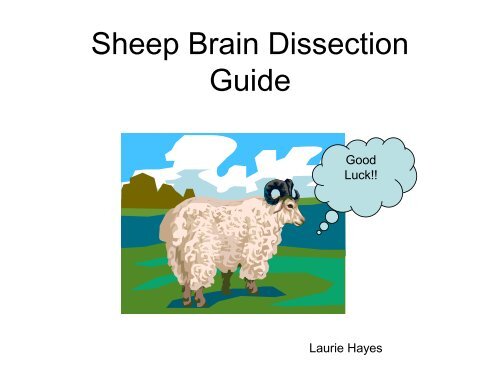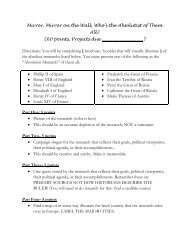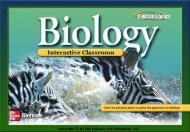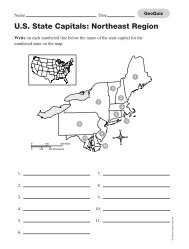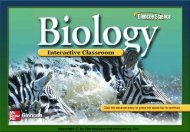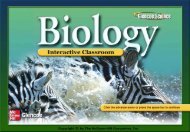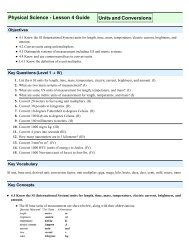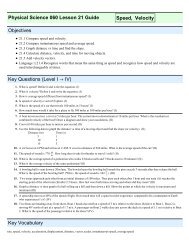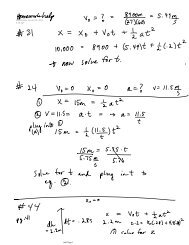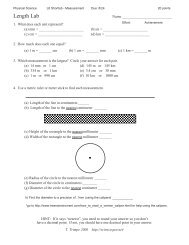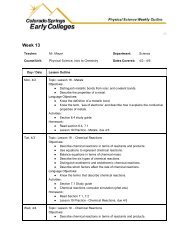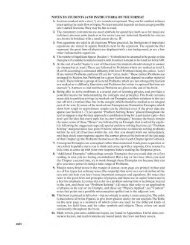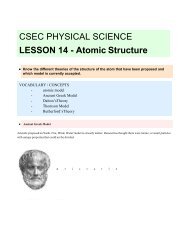Sheep Brain Dissection Guide
Sheep Brain Dissection Guide
Sheep Brain Dissection Guide
You also want an ePaper? Increase the reach of your titles
YUMPU automatically turns print PDFs into web optimized ePapers that Google loves.
<strong>Sheep</strong> <strong>Brain</strong> <strong>Dissection</strong><br />
<strong>Guide</strong><br />
Good<br />
Luck!!<br />
Laurie Hayes
To begin<br />
• Get gloves and a rubber apron or lab coat.<br />
Goggles are available if you would like<br />
them.<br />
• Pick up dissection tray, dull probe, pins<br />
and labels<br />
• Obtain a sheep brain and share this with a<br />
partner (or 2)<br />
• Rinse the sheep brain to remove<br />
preservative
Meninges of the <strong>Brain</strong><br />
<strong>Brain</strong> is protected by the skull and 3 layers of membranes called<br />
meninges
Observe Meninges<br />
• Examine the brain to see if there is a tough outer<br />
coat…This is the DURA MATER (literally means “tough<br />
mother”)<br />
• Now look for the stringy, web-like ARACHNOID MATER<br />
(literally means spider mother) beneath and stuck to the<br />
dura mater. The space under the arachnoid, the<br />
subarachnoid space, is filled with cerebrospinal<br />
fluid and contains blood vessels.<br />
• Look deeper and see an thin transparent membrane that<br />
follows the contour of the ridges (gyri) and valleys (sulci)<br />
of the brain. This is the PIA MATER ( means tender<br />
mother)
Questions<br />
• What is the function of the meninges<br />
• Describe the following meninges:<br />
Dura mater, Arachnoid mater, and Pia<br />
mater<br />
• What is meningitis
Main <strong>Brain</strong> Regions<br />
• Identify the cerebrum,<br />
brain stem) and<br />
cerebellum on your<br />
brain<br />
• Draw picture of sheep<br />
brain and label<br />
structures<br />
Cerebrum<br />
Cerebellum<br />
<strong>Brain</strong> stem
Questions<br />
• Which part of the brain allows for<br />
1) Balance<br />
2) Breathing<br />
3) Hearing and Vision
Human vs <strong>Sheep</strong><br />
• Compare the various<br />
areas of the sheep<br />
brain (cerebrum, brain<br />
stem, cerebellum) to<br />
the human brain.<br />
#4. How is it the same<br />
and How is it different<br />
Human brain
Identify Dorsal Structures<br />
• With the dorsal<br />
side up, identify<br />
the cerebral<br />
hemispheres, gyri,<br />
sulci,and<br />
longitudinal fissure<br />
on your sheep<br />
brain
Questions<br />
• What does the<br />
longitudinal fissure<br />
divide<br />
• What is the difference<br />
between gyri and<br />
sulci<br />
• What is the purpose<br />
of the gyri and sulci
Lobes of the Cerebrum<br />
• Find the 4<br />
lobes of the<br />
brain-frontal,<br />
parietal,<br />
occipital,<br />
and temporal<br />
• Using pins<br />
label each lobe<br />
• Teacher check
Questions<br />
• Name the lobe that functions in<br />
a) Hearing<br />
b) Vision<br />
c) Touch<br />
d) Movement
Corpus Callosum<br />
• At the longitudinal fissure, gently separate<br />
the two hemispheres and look down<br />
between them for the thick band of white<br />
fibers. This is the corpus callosum<br />
• What is its function
Identify Ventral Structures<br />
• Place the sheep brain<br />
ventral side up.<br />
• Identify the olfactory<br />
bulb, optic nerve,<br />
optic chiasm<br />
• Using pins label each<br />
structure.<br />
• Draw and label the<br />
structures in lab<br />
writeup
Questions<br />
• How does the human brain’s olfactory<br />
bulb differ from the sheeps<br />
• Which is able to smell more odors<br />
• Look at the optic chiasma. What happens<br />
to the optic nerve (vision) at the optic<br />
chiasma<br />
• Which side of the occipital lobe (right or<br />
left) “sees” for the right eye
<strong>Brain</strong> Stem<br />
• Look at the three<br />
parts of the brain<br />
stem-the midbrain<br />
(cerebral peduncle<br />
and mammilary<br />
body), pons and<br />
medulla oblongata<br />
• Pin and label parts<br />
• Teacher check
Function<br />
• Mammillary bodies<br />
serve as relay<br />
stations for reflexes<br />
related to sense of<br />
SMELL<br />
• Cerebral Pedunclegroup<br />
of myelinated<br />
nerves
Questions<br />
• Label your diagram with parts of midbrain<br />
and brain stem<br />
• What is the function of the medulla<br />
oblongata and pons<br />
• Could you survive without them<br />
• Why or Why not
Identify dorsal structures<br />
• Carefully pull the<br />
cerebellum away from<br />
the cerebrum. Don’t<br />
break any structures<br />
off.<br />
• Identify the pineal<br />
body, superior<br />
colliculi, and inferior<br />
colliculi.
Functions-Reflex Centers<br />
• Inferior Colliculimovement<br />
of head<br />
and trunk in response<br />
to sound stimuli<br />
• Superior Colliculimovement<br />
of eyes,<br />
head and neck in<br />
response to visual<br />
stimuli
Pineal Gland<br />
• Produces the<br />
hormone melatonin at<br />
night<br />
• Melatonin is the sleep<br />
hormone
• What is the function<br />
of the Pineal body<br />
Questions
Midsagittal Section<br />
• Obtain a brain the has been cut in half<br />
• Locate the brain stem parts: the medulla<br />
oblongata, the pons, cerebrum, and cerebellum
Cerebellum<br />
• Look at the cross section of the<br />
cerebellum. The inner structure is called<br />
the arbor vitae (living tree).<br />
Why is this a good name for it
Midsagittal Section<br />
• Locate the corpus callosum, thalamus,lateral<br />
ventricle, fourth ventricle and cerebral aqueduct
Questions<br />
– What is the function of the ventricles<br />
– The cerebral aquaduct allows for the<br />
circulation of the cerebral spinal fluid through<br />
the ventricles. What do you think would<br />
happen if the duct became blocked<br />
– How would that affect brain tissue
The End!!<br />
Good bye or in sheep language<br />
BAA BAA


